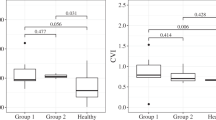Abstract
Purpose
The aim of this study was to determine the changes in the luminal and stromal areas of the choroid in eyes with Vogt-Koyanagi-Harada disease by optical coherence tomography (OCT).
Methods
A retrospective observational study. Choroidal images were recorded by enhanced depth imaging (EDI-OCT) at the baseline, and at 1 week and 1 month after initiating steroid therapy. The EDI-OCT images were converted to binarized images, and the luminal areas and the stromal areas were measured separately.
Results
Thirty-two eyes of 16 patients were enrolled, and 16 eyes of 10 patients had suitable images for the binarization analyses. The ratio of the luminal areas to the choroidal areas was 0.60 ± 0.03 at the baseline, 0.67 ± 0.04 at 1 week, and 0.66 ± 0.04 at 1 month. There was a significant increase from the baseline at 1 week (P < 0.01) but not from 1 week to 1 month. Although both the stromal and luminal areas were reduced, the percent reduction of the stromal areas (56.5 ± 7.2 %) was significantly greater than that of the luminal areas (42.5 ± 12.6 %) at 1 week (P < 0.01).
Conclusions
A significant decrease of the choroidal area was detected in eyes with Vogt-Koyanagi-Harada disease at 1 week after beginning steroid therapy. The decrease was more evident in the stromal area than in the luminal area.



Similar content being viewed by others
References
Moorthy RS, Inomata H, Rao NA (1995) Vogt-Koyanagi-Harada syndrome. Surv Ophthalmol 39:265–292
Ohno S (1981) Immunological aspects of Behcet’s and Vogt-Koyanagi Harada’s diseases. Trans Ophthalmol Soc U K 101:335–341
Weisz JM, Holland GN, Roer LN et al (1995) Association between Vogt-Koyanagi-Harada syndrome and HLA-DR1 and -DR4 in Hispanic patients living in southern California. Ophthalmology 102:1012–1015
Ohno S, Char DH, Kimura SJ, O’Connor GR (1977) Vogt-Koyanagi-Harada syndrome. Am J Ophthalmol 83:735–740
Inomata H, Sakamoto T (1990) Immunohistochemical studies of Vogt-Koyanagi-Harada disease with sunset sky fundus. Curr Eye Res 9(Suppl):35–40
Sakamoto T, Murata T, Inomata H (1991) Class II major histocompatibility complex on melanocytes of Vogt-Koyanagi-Harada disease. Arch Ophthalmol 109:1270–1274
Sonoda S, Nakao K, Ohba N (1999) Extensive chorioretinal atrophy in Vogt Koyanagi-Harada disease. Jpn J Ophthalmol 43:113–119
Rao NA (2007) Pathology of Vogt-Koyanagi-Harada disease. Int Ophthalmol 27:81–85
Nakao K, Mizushima Y, Abematsu N et al (2009) Anterior ischemic optic neuropathy associated with Vogt-Koyanagi-Harada disease. Graefes Arch Clin Exp Ophthalmol 24:1417–1425
Nakao K, Abematsu N, Mizushima Y, Sakamoto T (2012) Optic disc swelling in Vogt-Koyanagi-Harada disease. Invest Ophthalmol Vis Sci 53:1917–1922
Margolis R, Spaide RF (2009) A pilot study of enhanced depth imaging optical coherence tomography of the choroid in normal eyes. Am J Ophthalmol 147:811–815
Fong AH, Li KK, Wong D (2011) Choroidal evaluation using enhanced depth imaging spectral-domain optical coherence tomography in Vogt-Koyanagi- Harada disease. Reina 31:502–509
Maruko I, Iida T, Sugano Y et al (2011) Subfoveal choroidal thickness after treatment of Vogt-Koyanagi-Harada disease. Retina 31:510–517
Nakai K, Gomi F, Ikuno Y et al (2012) Choroidal observations in Vogt-Koyanagi Harada disease using high-penetration optical coherence tomography. Graefes Arch Clin Exp Ophthalmol 250:1089–1095
Nakayama M, Keino H, Okada AA et al (2012) Enhanced depth imaging optical coherence tomography of the choroid in Vogt-Koyanagi-Harada disease. Retina 32:2061–2069
da Silva FT, Sakata VM, Nakashima A et al (2013) Enhanced depth imaging optical coherence tomography in long-standing Vogt-Koyanagi-Harada disease. Br J Ophthalmol 97:70–74
Sonoda S, Sakamoto T, Yamashita T et al (2014) Choroidal structure in normal eyes and after photodynamic therapy determined by binarization of optical coherence tomographic images. Invest Ophthalmol Vis Sci 55:3893–3899
Sonoda S, Sakamoto T, Yamashita T et al (2015) Luminal and stromal areas of choroid determined by binarization method of optical coherence tomographic images. Am J Ophthalmol 159:1123–1131
Read RW, Holland GN, Rao NA et al (2001) Revised diagnostic criteria for Vogt-Koyanagi-Harada disease: Report of an international committee on nomenclature. Am J Ophthalmol 131:647–652
Oh H, Takagi H, Takagi C et al (1999) The potential angiogenic role of macrophages in the formation of choroidal neovascular membranes. Invest Ophthalmol Vis Sci 40:1891–1898
Hattenbach LO, Falk B, Nurnberger F et al (2002) Detection of inducible nitric oxide synthase and vascular endothelial growth factor in choroidal neovascular membranes. Ophthalmologica 216:209–214
Ando A, Yang A, Mori K et al (2002) Nitric oxide is proangiogenic in the retina and choroid. J Cell Physiol 191:116–124
Spaide RF (2009) Enhanced depth imaging optical coherence tomography of retinal pigment epithelial detachment in age-related macular degeneration. Am J Ophthalmol 147:644–652
Acknowledgments
The authors thank Prof. Duco Hamasaki, Miami University, for his critical discussion and editing of the final manuscript.
Author information
Authors and Affiliations
Corresponding author
Ethics declarations
Conflict of interest
All authors certify that they have no affiliations with or involvement in any organization or entity with any financial interest (such as honoraria, educational grants, participation in speakers’ bureaus, membership, employment, consultancies, stock ownership, or other equity interest, and expert testimony or patent-licensing arrangements), or non-financial interest (such as personal or professional relationships, affiliations, knowledge, or beliefs) in the subject matter or materials discussed in this manuscript.
Electronic supplementary material
Below is the link to the electronic supplementary material.
ESM 1
(DOCX 27 kb)
Rights and permissions
About this article
Cite this article
Kawano, H., Sonoda, S., Yamashita, T. et al. Relative changes in luminal and stromal areas of choroid determined by binarization of EDI-OCT images in eyes with Vogt-Koyanagi-Harada disease after treatment. Graefes Arch Clin Exp Ophthalmol 254, 421–426 (2016). https://doi.org/10.1007/s00417-016-3283-4
Received:
Revised:
Accepted:
Published:
Issue Date:
DOI: https://doi.org/10.1007/s00417-016-3283-4




